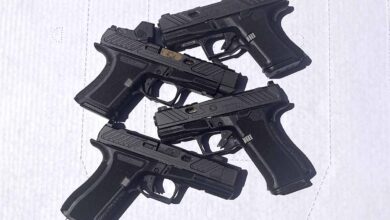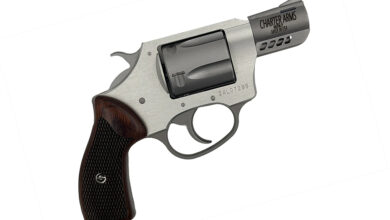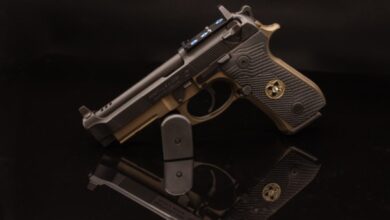Stevens Pocket Rifle: A Historical Rimfire

Before the National Firearms Act, the idea of a stocked pistol wasn’t all that crazy. Stocked pistols provided super short, maneuverable platforms that acted as some of the earliest semi-auto-stocked platforms. World War I, in particular, made use of stock pistols for close-quarters combat. A stock gives you one more point of stability and makes shooting a handgun much easier. Outside of the Great War, the idea of a stocked pistol wasn’t lost on everyone else. The Stevens Pocket Rifle is a nonmartial rifle designed to provide one of the handiest, lightest stocked platforms on the market.
The World of the Stevens Pocket Rifles
The Stevens Pocket Rifle gave shooters a single-shot rimfire firearm that came in .22, .25, and .32 Rimfire rounds. The little guns were often called bicycle rifles for their ease of carry on two-wheeled contraptions. These pocket rifles acted as breech-loading, single-shot platforms that resembled overgrown derringers. Not two-barrel derringers, of course. The idea behind the design was to make the firearm portion and the stock portion easy to carry.
Stevens Pocket Rifles came in several configurations. Barrel lengths varied quite a bit. Shooters could choose from 10, 12, 15, or 18-inch barrels, and there were also several sighting options. This included very adjustable peep sights, as well as fixed peep sights and open sights.
The Stevens Pocket Rifle was incredibly important to Joshua Stevens and the Stevens Arm and Tool Company. Joshua Stevens initially worked for a variety of different firearms companies before finally setting off on his own in 1864. He began his company by producing an ultra-small pocket pistol, which was a simple, single-shot pistol. The Pocket Rifle would be an evolution of the pocket pistol with a longer, heavier barrel and, of course, the attachment of a stock. The first pocket rifle was produced in 1869.
The stock was simple and made of thin metal. It was attached to the bottom and back of the grip and was quick and easy to attach and remove. The weapon cost $7.50 and came with a leather carrying case. Stevens advertised that the case would fit perfectly within the bicycle’s frame.
Finding Success
The Steven Pocket Rifle was a very successful design. It was light, handy, and reasonably affordable for a firearm of the era. The weapon’s popularity and success led to Stevens producing simple scopes for the guns and outfitting pocket rifles with slightly magnified optics. A small, lightweight, and easy-to-carry rifle provided a super handy platform for dealing with pests, small game hunting, and more.

Stevens’ biggest contribution was developing the .22LR cartridge. Stevens chambered various rifles in this caliber, including their Pocket Pistols and Pocket Rifles. The .22LR is one of the most successful rounds of all time.
The Pocket Rifle series succeeded and helped make Stevens a profitable company that later sold to New England Westinghouse, specifically to produce Mosin Nagant for Russia in World War I. Pro Tip: don’t ever make a deal with Russia if you’re a gun company. They have a long history of leaving American companies out to dry on weapon orders. After the Tsar bit the dust, New England Westinghouse never got paid for three-quarters of a million Mosins and struggled to stay afloat after that.

As you know now, the Stevens brand still exists. It was purchased by Savage in 1920 and has remained a Savage brand since. They haven’t produced any form of the Pocket Rifle since before World War I.
Enter The NFA
After the National Firearms Act, the idea of the Stevens Pocket Rifle faded away. Under the NFA, these would be considered short-barreled rifles and would require a $200 tax stamp. Remember, this rifle sold for $7.50 originally, and even if we adjusted and increased the cost to the 1930s, the stamp would still cost way more than the gun.

The NFA also caused a lot of owners of Pocket Rifles to destroy or abandon their stocks. No one wanted a hefty fee or long prison sentence for a single-shot rimfire rifle. This created a lack of stocks for the guns currently available. At some point, the ATF decided that these single-shot pocket rifles could be exempt from the NFA.
The Pocket Rifle In Living Color
The Stevens Pocket Rifle is still around. I picked one up in somewhat rough condition for a very low price. Sadly, that low price is mostly due to its stock being missing. Mine is basically a really big handgun at this point, but I am actively shopping for an original stock, but my searches are coming up empty.

My Pocket Rifle has a short ten-inch barrel and basic fixed peep sights. It’s also a .22LR model. This is my dream pocket rifle—it’s just missing the stock! Modern .22LR has gotten fast and hot, so I stay away from it. I just use 22 Short CB Cap loads. This gun is over a century old at this point, so I’m not going to be the one to destroy it.
These are single-action, hammer-fired guns. The user presses a small button on the left side of the gun, and the barrel separates from the breech. This opens the gun and makes it easy to load or get rid of the fired cartridge. The gun has an extractor but not an ejector. A small piece of metal pushes the case outward and makes it easy to pinch and toss.

The hammer is thumbed rearward, and the exposed trigger offers hardly any resistance. It’s a super lightweight trigger that’s ultra short. It’s a great trigger overall. The sights are most certainly made for a stock. The peep is about as small as it can get. It’s absurdly small and certainly not designed for speed. I had a really hard time shooting the gun without a stock due to how small the peep sight is, but I found a way.
The Way To Shoot The Pocket Rifle
Here is what we have to do. Take your non-dominant hand and form a “V” with your index finger and thumb. That is where you rest your long barrel. Use your index and thumb to pinch the barrel. Your firing hand gets a grip, and you pull the gun rearward toward your face. Your cheek now rests on the rear of your hand and establishes a cheek weld.
This allows you to get behind the sights and see the gun. Shooting with this position allows you to use the sights and engage the target. A .22LR doesn’t create enough recoil to make the gun tough to handle. It’s easy to hold in this position and easy to use that tight peep sight. When used properly, it’s crazy how accurate this gun can be.

The super tight peep sight and ultra-small front sight result in a sighting system that doesn’t obscure the target. This means that out to 25 yards, the gun is a sharpshooter capable of turning a soda can into a piece of Swiss cheese. Out to 50 yards, I can hit an IPSC target most of the time. The sights are tight but precise.
Even though it’s older than my great-grandfather, the Pocket Rifle is also reliable. The bigger hammer with the big firing pin makes the gun go bang every time, which is not bad for a rifle that was likely fired by a Civil War vet at least once.
The Legend
I imagine the Pocket Rifle concept would be quite popular these days if the NFA hadn’t created such a roadblock. The Pocket Rifle delivers a handy, lightweight, easy-to-shoot rifle design that can be absurdly accurate. I’d happily take the pocket rifle hunting and might just see how it handles squirrels this fall once they are fattened up.
The post Stevens Pocket Rifle: A Historical Rimfire appeared first on The Mag Life.
Read the full article here






